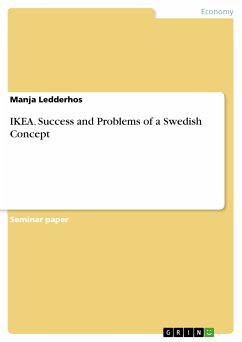
IKEA - Success and Problems of a Swedish Concept (eBook, ePUB)

PAYBACK Punkte
0 °P sammeln!
Seminar paper from the year 2003 in the subject Business economics - General, grade: very good, Mälardalen University (Institution of Economics), course: Strategies and the New Economy, language: English, abstract: 1.1. Background Information IKEA is a well known Swedish company where almost every European person under 30 has purchased something from to decorate their flats. In only a few decades the company "went from the woods of southern Sweden to 31 countries around the world"1 and has become a large Multinational cooperation (MNC) with an interorganisational network.2 Higher tariffs, tra...
Seminar paper from the year 2003 in the subject Business economics - General, grade: very good, Mälardalen University (Institution of Economics), course: Strategies and the New Economy, language: English, abstract: 1.1. Background Information IKEA is a well known Swedish company where almost every European person under 30 has purchased something from to decorate their flats. In only a few decades the company "went from the woods of southern Sweden to 31 countries around the world"1 and has become a large Multinational cooperation (MNC) with an interorganisational network.2 Higher tariffs, transport costs and the loss of economies of scale in domestic production further encourage production abroad.3 The Swedish market is comparably small and IKEA had to expand in order to keep their steady growth rates. The success came as a surprise to many since the furniture business is originally a local business.4 IKEA is the only company in their field, that has been able to expand so widely. The company seems to offer something that is unique to people and that appeals to them as something preferable. The background of the company seems to play a role in managing this uniqueness where Swedish influence on leadership, corporate culture and product offer leads towards the successful "IKEA spirit". While the internationalisation of IKEA is one of the reasons for their great success, it seems that it is also the source of trouble. It seems that today's "game of global strategy [is] increasingly ... a game of coordination"5. The difficulties that IKEA faces is to keep their unique "IKEA spirit" and still be successful around the world. 1.2. Aim of the Paper The aim of the paper is to look at the sources for IKEAs success where special emphasis will be given to the Swedish impact on leadership, corporate culture and product offer and the success they have with it. Internationalisation puts challenges on the above success areas and those need to be evaluated, as well. 1.3. Delimitations IKEA is a very complex company and I couldn't concentrate on all of the given information. For example, I did not write about the purchasing network and relationships to suppliers. Also, customer contacts are not dealt with in depth. 1 http://www.IKEA.com/about_IKEA/timeline/splash.asp, (21.02.03). 2 Forgens/Holm/Thilenius (1997). p.477. 3 Buckley/ Casson (1998). p. 555. 4 Grol/Schoch (1998), p.
Dieser Download kann aus rechtlichen Gründen nur mit Rechnungsadresse in A, B, BG, CY, CZ, D, DK, EW, E, FIN, F, GR, HR, H, IRL, I, LT, L, LR, M, NL, PL, P, R, S, SLO, SK ausgeliefert werden.













